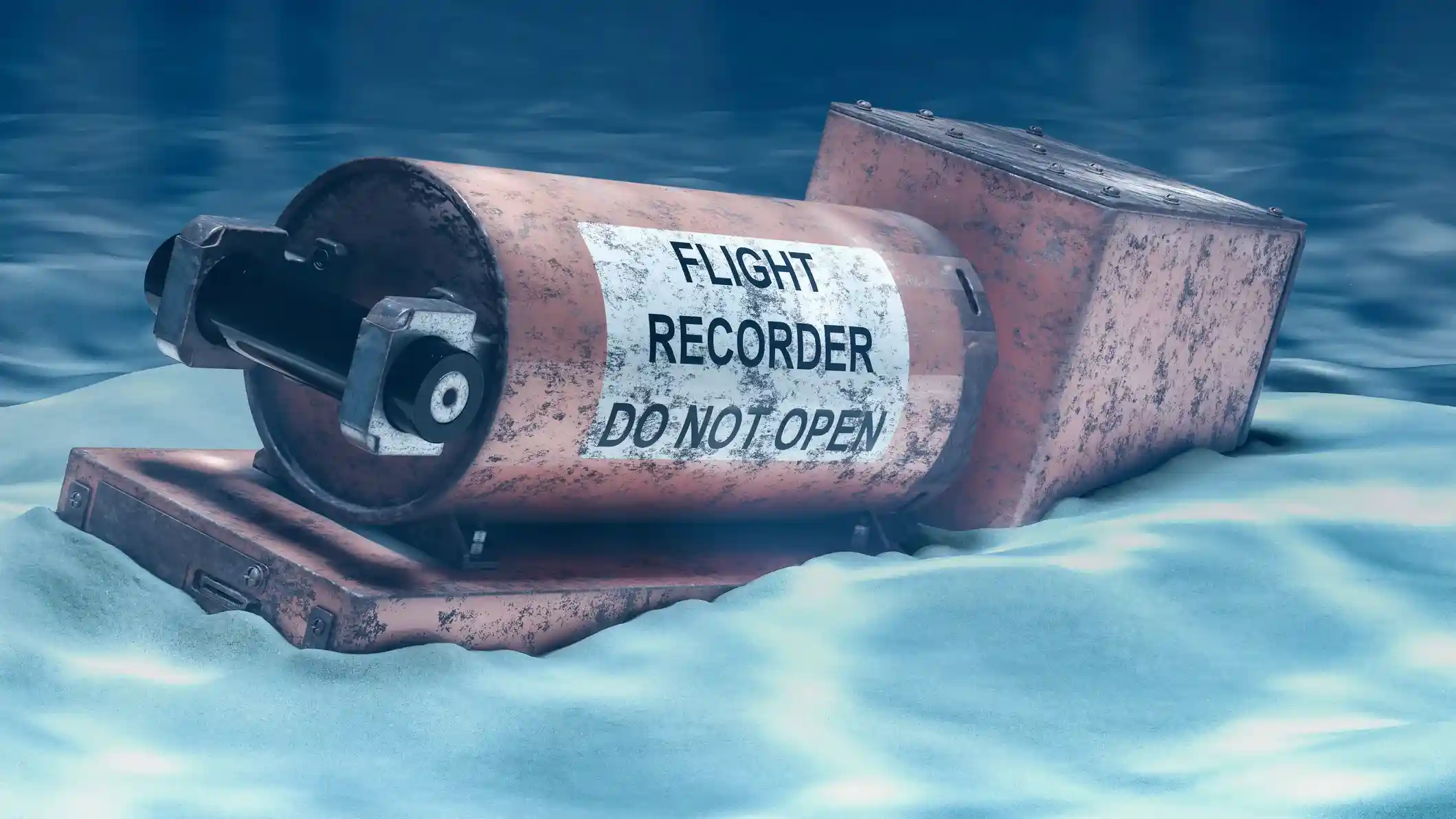Now Reading: Black Box Plane: The Detective That Solves Aviation Mysteries
-
01
Black Box Plane: The Detective That Solves Aviation Mysteries
Black Box Plane: The Detective That Solves Aviation Mysteries

The black box plane serves as aviation’s critical detective. It records vital flight data and cockpit audio during flights. After crashes, investigators use this information to determine what went wrong. Modern black boxes can withstand extreme conditions, helping improve air travel safety.
Airplanes are amazing machines. However, when a crash happens, we need answers fast. That’s where the black box plane comes in. Surprisingly, a black box isn’t black—it’s bright orange! For instance, these devices store vital clues about flights.
In this blog, we’ll explore what a black box is, how it works, and why it matters in plane crashes. So, let’s dive into the fascinating world of the black box in a plane.
What Is a Black Box on a Plane?
A black box in a plane is a special device that records flight information. Specifically, it includes two parts: the Flight Data Recorder (FDR) and the Cockpit Voice Recorder (CVR). Together, they capture data and conversations that help solve crash mysteries.
For example, the FDR tracks technical details like speed and altitude. Meanwhile, the CVR records pilot talks and cockpit sounds.
Importantly, black boxes are built to survive fires, water, and crashes. Although called “black boxes,” they’re orange to stand out in wreckage.
Why Are Black Boxes in Planes So Important?
Black boxes act like a plane’s memory. Without them, solving crashes would be tough. Here’s why they’re critical:
- Safety Improvements: Black box plane crash recordings help airlines fix issues. For instance, they prevent future accidents.
- Finding Causes: Investigators use data to check for human errors or mechanical failures. Additionally, weather issues can be spotted.
- Legal Evidence: Black box recordings are often used in court or insurance claims.
For example, in 2025, a cargo plane crash in the Pacific Ocean was solved using black box data. Specifically, the FDR showed a mechanical fault, leading to new safety rules.
How Does a Black Box in a Plane Work?
A black box of a plane is a high-tech tool built for tough conditions. Let’s break down its two parts:
Flight Data Recorder (FDR)
The FDR tracks hundreds of flight details. For example, it records:
- Altitude
- Airspeed
- Engine performance
- Flight path
Moreover, it collects data every second, storing it on crash-proof chips. In fact, the FDR can hold up to 25 hours of data, covering most flights.
Cockpit Voice Recorder (CVR)
The CVR captures all cockpit sounds. Specifically, it records:
- Pilot conversations
- Radio communications
- Alarms and noises
For instance, the CVR stores the last two hours of audio. However, in 2025, some CVRs can save up to 25 hours, matching the FDR. Both devices sit in the plane’s tail for maximum crash protection. Additionally, they resist fire, water, and impacts up to 20,000 feet underwater.
Black Box Plane Crash Recordings: What Do They Reveal?
Black box plane crash recordings are like a window into the past. For example, they show what happened before a crash. The CVR might capture a pilot’s warning about storms. Meanwhile, the FDR could reveal engine issues. Together, these clues solve mysteries.
In 2024, a European plane crash was solved using black box data. Specifically, the CVR showed pilots discussing a bird strike. Additionally, the FDR confirmed engine failure.
As a result, airports introduced stricter bird control measures. However, finding black boxes isn’t always easy. For instance, in deep-sea crashes, recovery can take months.
In 2025, a Pacific Ocean crash required advanced drones to locate the plane crash black box.
How Are Black Boxes Found After a Crash?
Finding a black box in a plane crash is urgent. For example, black boxes have beacons that send signals for up to 90 days. These signals help teams find boxes in oceans or remote areas. Here’s the process:
- Search Teams Deploy: Teams use sonar and drones to scan crash sites.
- Beacon Signals: The black box’s beacon emits a “ping” underwater.
- Recovery: Divers or robots retrieve the box for lab analysis.
In 2025, new technology has improved recovery. For instance, beacons now last longer, and drones dive deeper. As a result, searches are faster and more effective.
Table: Key Facts About Black Boxes in Planes
| Feature | Details |
| Color | Bright orange (not black) |
| Components | Flight Data Recorder (FDR) and Cockpit Voice Recorder (CVR) |
| Data Storage | FDR: Up to 25 hours; CVR: 2–25 hours (depending on model) |
| Survival Conditions | Withstands fire, water, and impacts up to 20,000 feet underwater |
| Location in Plane | Tail section for maximum crash protection |
| Beacon Duration | Up to 90 days (2025 models) |
Challenges in Using Black Box Plane Crash Recordings
Black boxes are powerful, but they have limits. For example, here are some challenges:
- Damage: Rarely, black boxes get damaged, making data hard to read.
- Location: In deep oceans, finding the box can take months.
- Privacy Concerns: Black box recordings plane crashes include private pilot talks, raising ethical issues.
- Data Overload: Modern FDRs record so much data that analysis takes time.
However, in 2025, new software speeds up data analysis, solving cases faster.
The Future of Black Boxes in Planes
Aviation is always improving, and so are black boxes. For instance, in 2025, experts are testing new features:
- Real-Time Data Streaming: Some planes send black box data to the cloud during flights. As a result, boxes may not need to be found after crashes.
- Longer Battery Life: New beacons last up to 120 days, improving recovery.
- AI Analysis: Artificial intelligence analyzes plane crash black box recordings faster.
These changes will make flying safer. However, they also bring concerns about costs and privacy.
How Black Boxes Improve Aviation Safety
Black box plane data does more than solve crashes—it prevents them. For example, airlines use it to:
- Train pilots better
- Improve plane designs
- Update safety rules
In 2024, a crash in Asia showed a software glitch in the autopilot. As a result, a global software update was issued.
Moreover, black boxes help families find closure by explaining crashes. Additionally, they ensure accountability for airlines and manufacturers.
Common Myths About Black Boxes in Planes
There are many myths about black boxes. Let’s clear them up:
- Myth: Black boxes are indestructible.
Fact: They’re tough but can be damaged in extreme crashes. - Myth: Black boxes are black.
Fact: They’re orange for visibility. - Myth: Black boxes record everything.
Fact: They only capture specific flight data and audio.
For instance, knowing these facts helps us understand the black box of a plane better.
Conclusion: The Vital Role of the Black Box Plane
The black box plane is a small but powerful tool. For example, it unlocks crash mysteries and saves lives. From black box plane crash recordings to advanced recovery, these devices are key to aviation safety.
As technology grows, black boxes will keep making flying safer. So, next time you fly, know the black box is there, quietly recording, ready to tell its story if needed. Stay curious, and fly safe!
FAQs
A plane’s black box records flight data and cockpit audio. Specifically, it includes the FDR and CVR, helping solve crash mysteries.
It’s a device with two parts (FDR and CVR) that stores flight information. For example, it’s used to investigate crashes.
A black box is an orange device recording flight data and pilot talks. Moreover, it’s vital for crash investigations.
Black boxes are FDR and CVR devices. For instance, they track flight details and audio to solve crashes.What is the black box on a plane?
It’s a crash-resistant device storing flight data and audio. Additionally, it improves aviation safety.

Ethan Cole is an American journalist with expertise across weather, tech, travel, and culture. With over 15 years of experience, he delivers sharp, reader-friendly stories that simplify complex topics and connect with audiences worldwide.
Stay Informed With the Latest & Most Important News
Previous Post
Next Post
-
 01Happy Gilmore 2: Your Complete Guide to the Golf Comedy Sequel
01Happy Gilmore 2: Your Complete Guide to the Golf Comedy Sequel -
 02Joe Root’s Test Runs: England’s Batting Genius in Focus
02Joe Root’s Test Runs: England’s Batting Genius in Focus -
 03The Bad Guys 2 (2025): Everything We Know So Far
03The Bad Guys 2 (2025): Everything We Know So Far -
 04Demon Slayer: Kimetsu no Yaiba The Movie: Infinity Castle Tickets – Your Guide to the Epic Anime Event
04Demon Slayer: Kimetsu no Yaiba The Movie: Infinity Castle Tickets – Your Guide to the Epic Anime Event -
 05RTX 50 Series Unleashed: Next-Gen Gaming Power Awaits!
05RTX 50 Series Unleashed: Next-Gen Gaming Power Awaits! -
 06The Naked Gun 2025: What to Know About the Comeback Comedy Starring Liam Neeson
06The Naked Gun 2025: What to Know About the Comeback Comedy Starring Liam Neeson -
 07Sensory Clothing for Kids: What Every Parent Needs to Know
07Sensory Clothing for Kids: What Every Parent Needs to Know














